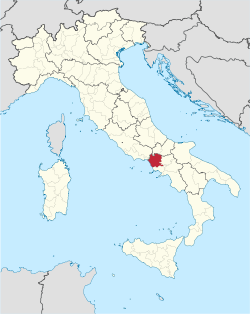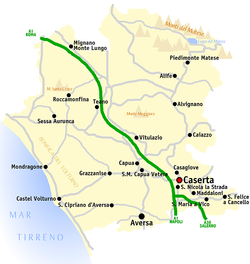Theprovince of Caserta(Italian:provincia di Caserta) is aprovincein theCampaniaregion ofItaly.Its capital is the city ofCaserta,situated about 36 kilometres (22 mi) by road north ofNaples.[3]The province has an area of 2,651.35 square kilometres (1,023.69 sq mi), and had a total population of 924,414 in 2016. ThePalace of Casertais located near to the city, a former royal residence which was constructed for the Bourbonkings of Naples.It was the largestpalaceand one of the largest buildings erected in Europe during the 18th century. In 1997, the palace was designated aUNESCOWorld Heritage Site.[4]
Province of Caserta | |
|---|---|
 Monti Trebulani | |
 Map highlighting the location of the province of Caserta in Italy | |
 Map of the province of Caserta | |
| Country | |
| Region | Campania |
| Capital(s) | Caserta |
| Comuni | 104 |
| Government | |
| • President | Giorgio Magliocca |
| Area | |
| • Total | 2,651.35 km2(1,023.69 sq mi) |
| Population (1 January 2016)[1] | |
| • Total | 924,414 |
| • Density | 350/km2(900/sq mi) |
| GDP | |
| • Total | €14.536 billion (2015) |
| • Per capita | €15,723 (2015) |
| Time zone | UTC+1(CET) |
| • Summer (DST) | UTC+2(CEST) |
| Postal code | 81100 Caserta, 81010-81059 other communes |
| Telephone prefix | 081, 0823 |
| Vehicle registration | CE |
| ISTAT | 061 |
History
editThe province of Caserta in the historical Terra di Lavoro region,[5]also known as Liburia, covered the greatest expanse of territory around the 13th century when it extended from theTyrrhenian Seaand the islands ofPonzaandVentoteneto theApenninesand the southern end of the Roveto Valley. In the Kingdom of Naples and the Kingdom of the Two Sicilies, Caserta was one of the most important departments in southern Italy.
The first capital of the region was the ancient city ofCapuauntil 1818, thenCaserta.[5]In addition to Naples, the most important centers were Caserta, Capua,Nola,Gaeta,Sora,Aversa,Teano,andIsola Liri.In 1816, during the French occupation,Joseph Bonapartereformed the territorial division of the kingdom of Naples, on the basis of the French model. A series of royal decrees completed the reforms, introducing local administrative units or communes like theFrench ones.The new Napoleonic reforms led to the establishment of theprovince of Naples.In 1863, after the annexation of the Kingdom of Italy, the northeasterncomuni(municipalities) of Terra di Lavoro became part of the province of Campobasso,[6]andVenafroand the surrounding areas were later transferred to the province of Isernia, established in the 1870s. In 1927,Benito Mussolinidecided to dissolve the province of Terra di Lavoro, uniting much of its territory and thePontine Islandsto the province of Naples, although municipalities nearPiedimonteandAlifewere distributed between the provinces of Benevento and Campobasso and the districts of Sora and Gaeta went to the province of Rome. In 1945, a Decree signed byUmberto di Savoiareconstituted the province of Caserta, and finally in 1970, the modern province came into being.[6]
Geography
editThe territory of the province of Caserta, which lies on the southwestern part of central Italy, is bordered to the north by theMatesemountains belonging to theApenninesand by undulating hills, and to the south and west by plains of various types. To the northeast, near the Matese mountains is the Lago del Matese. The highest point isMonte Milettoat 2,050 m (6,730 ft),[7]divided betweenCampaniaandMolise.Thekarstmassif is rich in water and minerals, and contains many caves and mountain lakes. Other mountainous areas of note includeMonte Santa Croce,with the extinct volcano of Roccamonfina, on the border with Lazio, the Trebulani Mountains, in the central part of the province to the north includingMonte Maggiorereaching 1,036 m (3,399 ft), and the Tifatini Mountains to the south. TheVolturno Riverflows through the centre of the province with a defensive outpost at Capua.[8]The southern highlands of Caserta border theprovince of Benevento.
Comuni
editThere are 104comuni(sg.:comune) in the province:[9]
- Ailano
- Alife
- Alvignano
- Arienzo
- Aversa
- Baia e Latina
- Bellona
- Caianello
- Caiazzo
- Calvi Risorta
- Camigliano
- Cancello e Arnone
- Capodrise
- Capriati a Volturno
- Capua
- Carinaro
- Carinola
- Casagiove
- Casal di Principe
- Casaluce
- Casapesenna
- Casapulla
- Caserta
- Castel Campagnano
- Castel Morrone
- Castel Volturno
- Castel di Sasso
- Castello del Matese
- Cellole
- Cervino
- Cesa
- Ciorlano
- Conca della Campania
- Curti
- Dragoni
- Falciano del Massico
- Fontegreca
- Formicola
- Francolise
- Frignano
- Gallo Matese
- Galluccio
- Giano Vetusto
- Gioia Sannitica
- Grazzanise
- Gricignano di Aversa
- Letino
- Liberi
- Lusciano
- Macerata Campania
- Maddaloni
- Marcianise
- Marzano Appio
- Mignano Monte Lungo
- Mondragone
- Orta di Atella
- Parete
- Pastorano
- Piana di Monte Verna
- Piedimonte Matese
- Pietramelara
- Pietravairano
- Pignataro Maggiore
- Pontelatone
- Portico di Caserta
- Prata Sannita
- Pratella
- Presenzano
- Raviscanina
- Recale
- Riardo
- Rocca d'Evandro
- Roccamonfina
- Roccaromana
- Rocchetta e Croce
- Ruviano
- San Cipriano d'Aversa
- San Felice a Cancello
- San Gregorio Matese
- San Marcellino
- San Marco Evangelista
- San Nicola la Strada
- San Pietro Infine
- San Potito Sannitico
- San Prisco
- San Tammaro
- Sant'Angelo d'Alife
- Sant'Arpino
- Santa Maria Capua Vetere
- Santa Maria a Vico
- Santa Maria la Fossa
- Sessa Aurunca
- Sparanise
- Succivo
- Teano
- Teverola
- Tora e Piccilli
- Trentola-Ducenta
- Vairano Patenora
- Valle Agricola
- Valle di Maddaloni
- Villa Literno
- Villa di Briano
- Vitulazio
References
edit- ^Population data fromIstat
- ^Regions and Cities > Regional Statistics > Regional Economy > Regional Gross Domestic Product (Small regions TL3),OECD.Stats. Accessed on 16 November 2018.
- ^"Province of Caserta"(Map).Google Maps.Retrieved18 September2014.
- ^Italy Green Guide Michelin 2012-2013.Michelin Travel Publications. 1 March 2012. p. 264.ISBN978-2-06-718235-6.
- ^abDomenico, Roy Palmer (2002).The Regions of Italy: A Reference Guide to History and Culture.Greenwood Publishing Group. p. 70.ISBN978-0-313-30733-1.
- ^ab"Un po' di storia".Ministero della Giustizia.Retrieved18 September2014.
- ^Italy: A Complete Guide to 1,000 Towns and Cities and Their Landmarks, with 80 Regional Tours.Touring Editore. January 1999. p. 104.ISBN978-88-365-1522-6.
- ^Caserta, Benevento and Avellino, Italy: Frommer's ShortCuts.Frommer's, John Wiley & Sons. 5 April 2012. p. 12.ISBN978-1-118-19903-9.
- ^"Comunes".Upinet.it. Archived fromthe originalon 7 August 2007.Retrieved18 September2014.
- ^"Il Palazzo".
- ^FERRAND, Franck (October 24, 2013).Dictionnaire amoureux de Versailles.Place des éditeurs.ISBN9782259222679– via Google Books.
External links
edit- Official website(in Italian)

